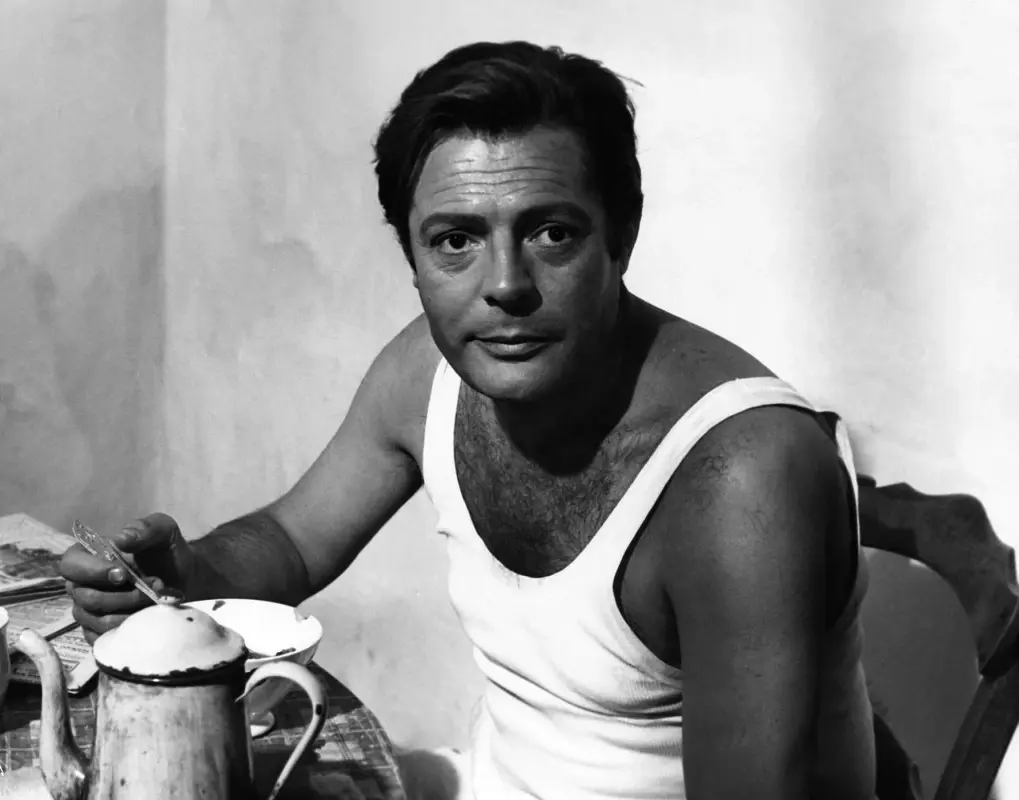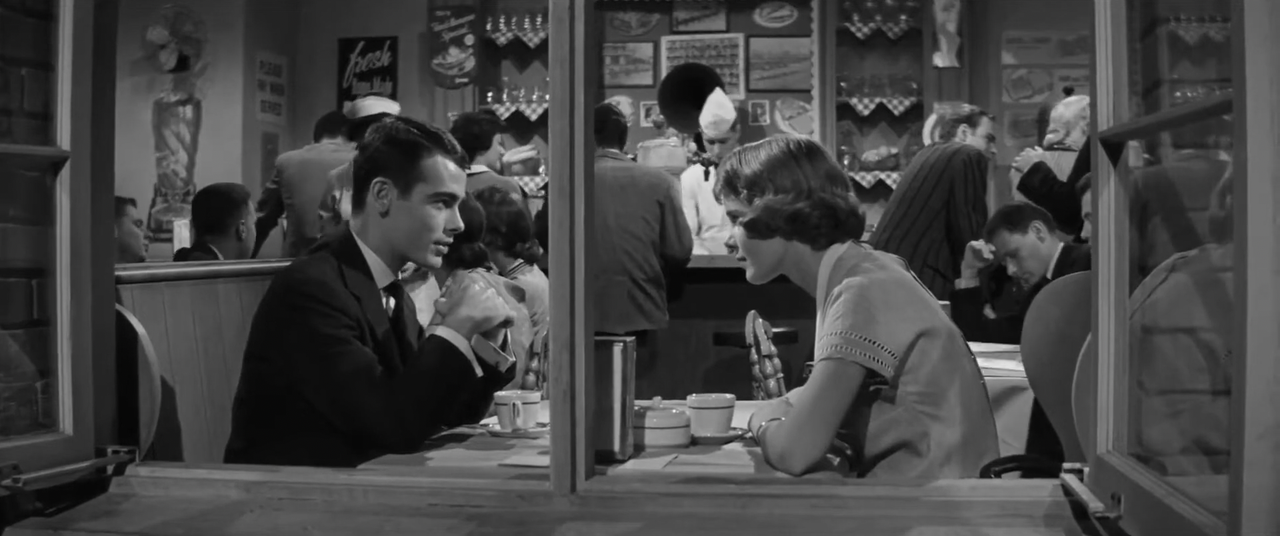“We'll eat Chinese. OK?”La piscine [The Swimming Pool] (Jacques Deray, 1969)
Jul
13
“Chinese food”

The two couples (Delon and Schneider, and Ronet and Birkin) awkwardly share dinner. There's wine in red glasses and the food, plated on rustic French dinnerware, is handled with chopsticks. DP: Jean-Jacques Tarbès.
crime
“Stop to eat every 8 hours. Just sandwiches.”Plunder Road [The Violent Road] (Hubert Cornfield, 1957)
Jul
10
sandwiches

At a diner, a dark-haired waitress holds up a carafe with fresh coffee and a take-away cup. A man in the background appears to keep an eye on her. DP: Ernest Haller.
“It isn't Jesus. It's just a fella.”Whistle Down the Wind (Bryan Forbes, 1961)
Jul
9
white bread

A child grabs a thick slice of white bread while the cutlery on her plate indicates she's finished eating. DP: Arthur Ibbetson.
– Charlie Bostock
“Good night, Gentle Jesus. Sleep well.”Whistle Down the Wind (Bryan Forbes, 1961)
Jul
9
Barn Day

The man (Alan Bates) in the barn surrounded by little children. The older girl in the light coat, Kathy, is played by Hayley Mills, author Mary Hayley Bell's daughter. DP: Arthur Ibbetson.
In the barn of a remote Lancashire farmhouse, three children stumble upon a stranger. Confused, they conclude that the fellow must be the Second Coming of Christ. In the world of the adults, a man is wanted by the police.
– Charlie Bostock
“Jesus Christ has promised to forgive you 490 times, whatever you have done… because those were his words. But about the 491st time… He has given no words. None at all.”491 (Vilgot Sjöman, 1964)
Jul
7
Global Forgiveness Day

One of the juvenile delinquents carving a simple arithmetical calculation into a desk during the Reverend's lecture about forgiveness. DP: Gunnar Fischer.
Early 60s, Sweden. A social experiment. Six hopelessly criminal juveniles are packed in a guesthouse – cynically named Objectivity – and loosely supervised by social workers and a reverend. The public servants speak of a new lease on life, God's servant of how Jesus forgives; all speak on their own behalf. We follow the young men closely and sense their need to break out, to be young, to be out of that house. We learn that their world, in or out, is eternally equally irrelevant.
– Reverend Mild
Vilgot Sjöman's 491 is an extremely, bleak, aggressive, and hopeless depiction of youth in postwar Sweden. Forgiveness is a tool of power, a method of control. And as empty as a repetitive lecture.
Lo straniero [The Stranger] (Luchino Visconti, 1967)
Jul
3
soup

Arthur Meursault (Mastroianni) eating from a cracked bowl. DP: Giuseppe Rotunno.
O Bandido da Luz Vermelha [The Red Light Bandit] (Rogério Sganzerla, 1968)
Jul
1
prairie oyster

The bandit (Paulo Villaça) cracks a raw egg over his liquid breakfast while one of his female victims (Sonia Braga) is on the phone beside him. Her cigarette smokes itself and the kitchen table is packed with drugstore items. DPs: Peter Overbeck & Carlos Ebert.
“Europe, a Stutz Bearcat, the best restaurants. You fellas really have a hard life, don't you?”Compulsion (Richard Fleischer, 1959)
Jun
29
coffee

A squeaky young Stockwell and Varsi at a diner. We're looking in from the outside through an open window. The place is busy but she's all enthralled by his wit and intellect (and looks for sure). DP: William C. Mellor.
– Harold Horn, DA
“He's still alive.”Muerte de un ciclista [Death of a Cyclist / Age of Infidelity] (Juan Antonio Bardem, 1955)
Jun
28
National Insurance Awareness Day

Juan (Alberto Closas) looking out at María José (Lucia Bosè) and the car after the crash. The cyclist is never shown. The scene echoes Beckett's Waiting for Godot. DP: Alfredo Fraile.
A car crash on National Insurance Awareness Day (USA)
A couple rushing home at night hit a cyclist. Despite knowing that the man's still alive, they opt to leave the site of the #crash and never mention it again. News reports about the death of the cyclist cause a rupture; because of the couple's #class differences – she a wealthy socialite, he a former falange soldier turned university professor – because they're lovers, and because no one can know about their whereabouts on the night of the accident.
Striking about Bardem's Muerte de un ciclista is its outsiderness in the Spanish film landscape. By adopting the visual language of both Italian #Neorealismo and Hollywood #melodrama, Bardem elegantly circumvents #Francoist censorship.
– Aw, mom. You always talk about civilization. – Don't knock it, son. Jeopardy (John Sturges, 1953)
Jun
25
National Camp Counts Day

Behind the scenes. Barbara Stanwyck as unhappy camper Helen Stilwin having her lipstick reapplied by makeup man Pat McNalley. DP: Victor Milner.
A nuclear family of three goes out on a #camping-slash-fishing-trip on a remote Mexican beach. On arrival, son Bobby (Lee Aaker) causes trouble by climbing a rickety old jetty, which then collapses after dad Doug (Barry Sullivan) frees the boy's stuck foot. Now with Doug stuck and the tide rolling in, Helen (Barbara Stanwyck) is on her own and needs to find a rope. And help…
John Sturges' Jeopardy is a thrilling reverse home invasion based on Maurice Zimm's radioplay A Question of Time. Without falling into the trap of an illustrated radio broadcast, the haunting photography by Victor Milner, small, intense cast, short runtime and claustrophobic sets make for a very modern, economic thriller.
And Barbara Stanwyck the type of heroine we wouldn't see much of until decades later.